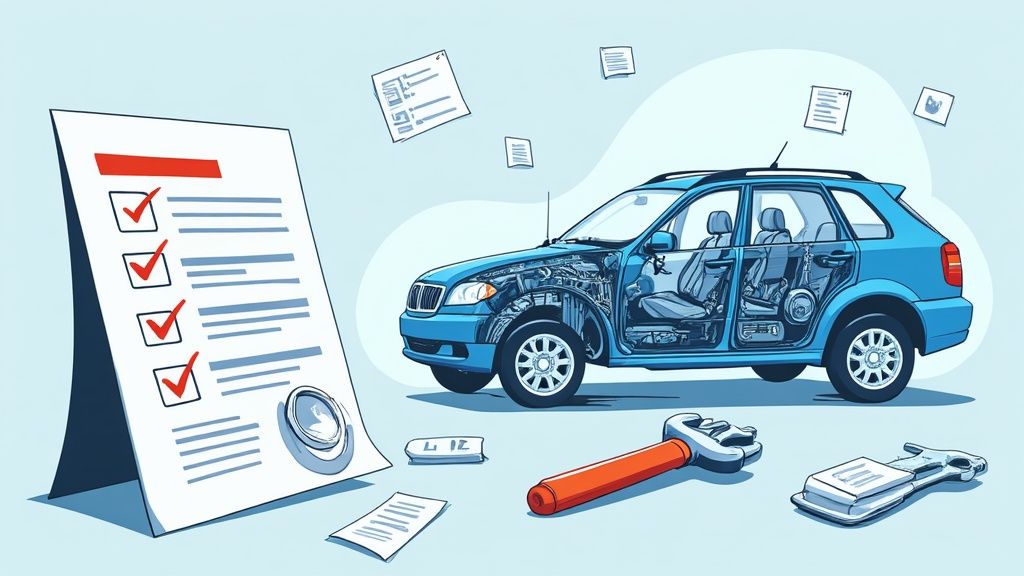
Used Car Inspection Checklist: Expert Guide to Smart Vehicle Assessment
Why Professional Used Car Inspection Matters
Buying a used car can save you money compared to purchasing new, but those savings can quickly disappear if the vehicle has hidden problems. A professional inspection provides detailed insights that go far beyond what most buyers can spot on their own. By thoroughly examining the vehicle’s history and mechanical condition, an expert evaluation helps prevent costly surprises down the road.
A trained mechanic knows exactly what to look for during an inspection. They can identify subtle warning signs like mismatched paint colors or uneven panel gaps that may indicate past accidents and structural damage. Their expertise also allows them to properly assess critical mechanical components including the engine, transmission, and brakes - catching potential issues before they become expensive repairs.
Some buyers try to skip the professional inspection to save money upfront, but this often proves to be an expensive mistake. Consider this: 40% of used vehicles have had previous repairs, highlighting why thorough evaluations are so important. Looking for issues like misaligned body panels or requesting vehicle history reports can reveal crucial details about past accidents and maintenance. Learn more about evaluating used cars here: How to Spot a Reliable Used Car
Benefits of a Professional Used Car Inspection
- Uncovers Hidden Problems: Experts can spot issues like frame damage, flood damage, or odometer tampering that buyers often miss
- Saves Money on Repairs: Finding problems early helps avoid unexpected and expensive fixes later
- Provides Negotiating Power: A detailed inspection report gives you leverage to negotiate price reductions for needed repairs
- Offers Peace of Mind: Professional evaluations give you confidence in your purchase decision
What a Professional Inspection Covers
- Mechanical Inspection: Complete evaluation of engine, transmission, brakes, suspension, steering and other key systems
- Exterior Inspection: Assessment of body damage, rust, paint condition, tires and wheels
- Interior Inspection: Review of cabin wear, feature functionality, and signs of previous damage
- Road Test: Performance evaluation under various driving conditions to check handling, noises, and system operations
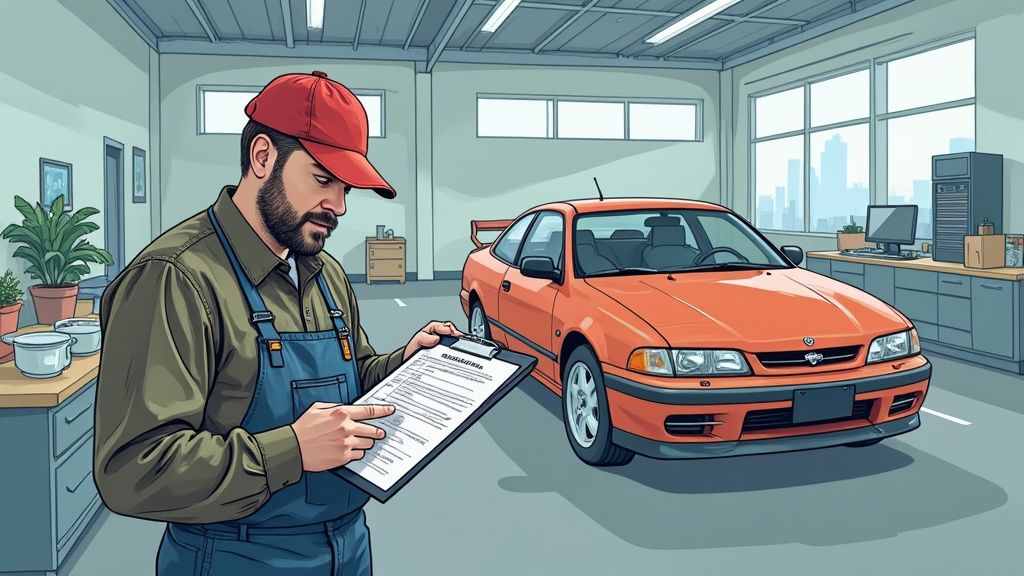
A professional inspection provides the detailed vehicle assessment needed to make a smart purchasing decision. While it requires an upfront investment, it can prevent much larger expenses later on. Let’s examine the key steps involved in a complete inspection process.
The Complete 155-Point Inspection Guide
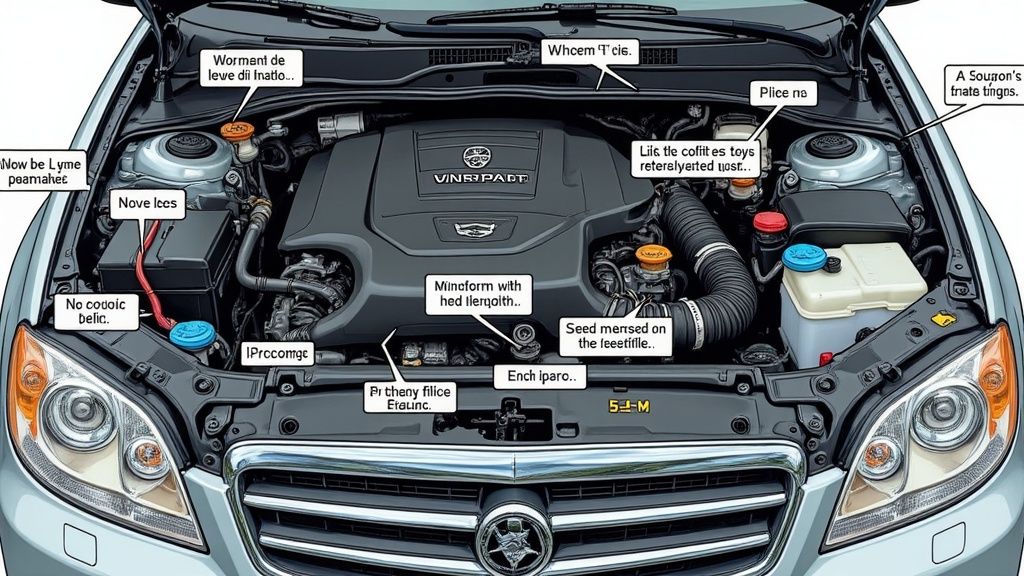
Just like a doctor performing a thorough physical exam, a proper used car inspection needs to examine every system and component carefully. The 155-point inspection provides a systematic method to thoroughly evaluate a used vehicle, ensuring you uncover any potential issues before making your purchase.
A full inspection typically covers 155 or more specific checkpoints. For instance, CARCHEX offers a comprehensive inspection that examines everything from the vehicle’s VIN to detailed assessments of both exterior and interior components. This includes checking for body damage, testing all lights and signals, and evaluating interior features like air conditioning and audio systems.
Exterior Inspection
The exterior check requires a detailed examination of several key areas:
- Body Panels: Close inspection of panel alignment, gaps between panels, and paint condition to spot signs of previous accidents
- Underbody: Assessment of rust damage, frame integrity, and fluid leaks
- Tires and Wheels: Evaluation of tread depth, wear patterns, and rim condition to identify tire life and alignment problems
- Lights and Signals: Testing of all exterior lighting including headlights, brake lights, and turn signals
Interior Inspection
Inside the vehicle, inspectors look at both appearance and functionality:
- Seats and Upholstery: Assessment of wear patterns, staining, and damage
- Dashboard and Controls: Verification that all gauges, warning lights, and controls work properly
- Safety Features: Testing of seatbelts, airbag systems, and other safety equipment
Mechanical Inspection
The mechanical inspection forms the core of the 155-point checklist:
- Engine: Full check for leaks, unusual sounds, and proper operation
- Transmission: Assessment of shift quality, fluid condition, and operation
- Brakes: Thorough inspection of brake components including pads, rotors, and lines
- Suspension: Testing of shocks, struts, and other suspension parts
- Steering: Evaluation of steering response and wheel alignment
This detailed approach helps create a complete picture of the vehicle’s condition. By examining each component systematically, you’ll have the information needed to make a smart purchase decision. Keep records of your inspections and future maintenance with tools like Auto Service Logger to track your vehicle’s condition over time.
Essential Road Testing Procedures
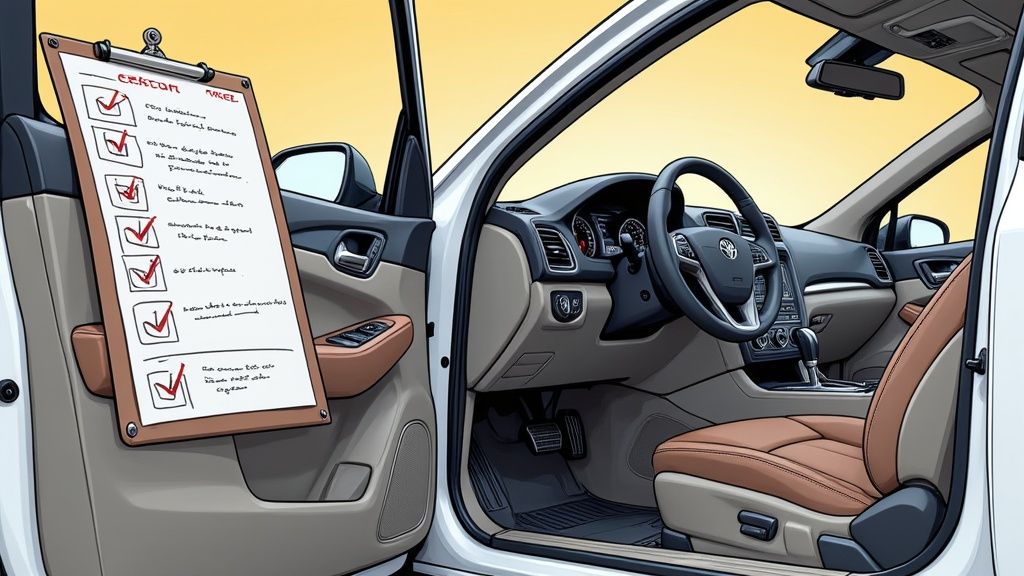
When inspecting a used car, looking under the hood is just the beginning. Taking the vehicle for a thorough road test is essential for uncovering potential issues that may not be visible during a stationary inspection. Just as a doctor needs to check vital signs, test driving lets you experience firsthand how the car actually performs on the road.
The Federal Trade Commission (FTC) strongly recommends getting an independent inspection before buying any used vehicle. Many problems can only be identified by a professional mechanic during actual driving conditions. Testing the car on various road types - hills, highways, and city streets - provides a complete picture of its mechanical condition and reveals how it handles different driving situations.
Key Areas to Focus On During a Road Test
- Steering: Check if the wheel vibrates or pulls to one side. The steering should feel responsive and smooth, without any concerning movement that could signal alignment problems.
- Brakes: Test both regular and parking brakes thoroughly. Listen for squealing or grinding while braking. The pedal should feel firm and bring the car to a smooth, controlled stop without pulling to either side.
- Transmission: Pay attention to how smoothly the transmission shifts between gears. For manual transmissions, check that the clutch engages cleanly. Any delayed response, grinding, or slipping needs investigation.
- Engine: Monitor engine response during acceleration and hill climbing. Note any unusual sounds or vibrations. The engine should run smoothly and provide steady power without hesitation.
- Suspension: Drive over different road surfaces to test ride quality. The car should feel stable and controlled, absorbing bumps without excessive bouncing or concerning noises from underneath.
Interpreting Road Test Results
Understanding what the car tells you during a test drive is crucial for making an informed buying decision. For example, steering wheel vibration often points to wheel balance issues, while a car that pulls to one side typically indicates brake or alignment problems. Any concerning engine noises or transmission behavior warrants professional inspection.
Taking detailed notes during the road test creates a valuable record of the car’s condition. This documentation helps track any developing issues and provides important historical context if problems arise later. A thorough road test, combined with a professional inspection, gives you the best chance of avoiding costly surprises after purchase. Never skip this critical step when evaluating a used vehicle.
Documentation and History Verification
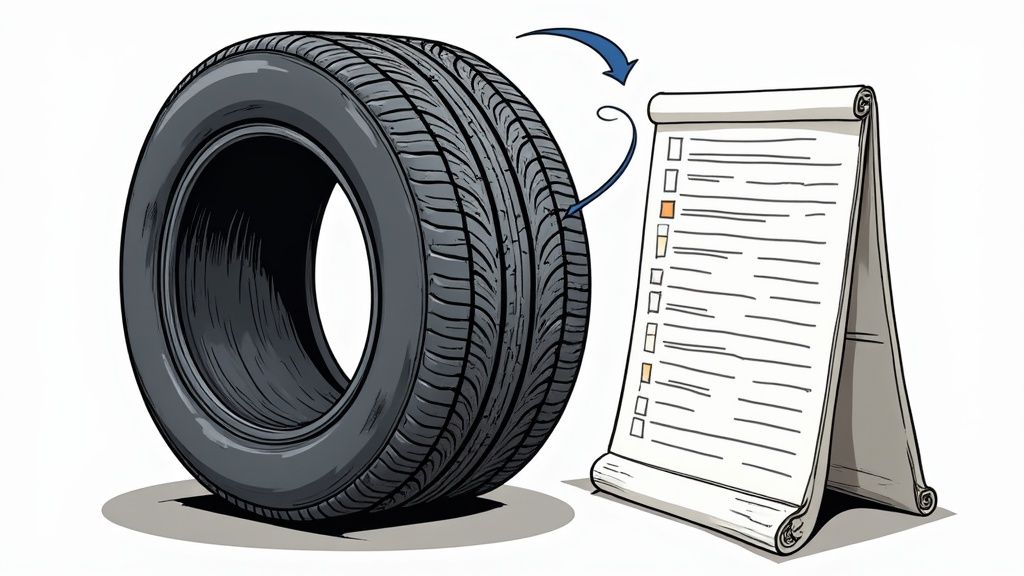
While test driving a used car is essential, checking its documentation and history is just as important. A close look at the paperwork helps spot potential issues that might not be visible during a physical inspection. Taking time to review these documents carefully can prevent major headaches and expenses later on.
Title and Registration Check
Start by examining the title and registration documents carefully. Make sure the seller’s name matches the title and verify that the Vehicle Identification Number (VIN) on the title is identical to the one on the vehicle. If you notice any differences between these documents, consider it a serious warning sign - this could indicate the car was stolen or has other legal problems.
Vehicle History Report
Getting a vehicle history report is your next crucial step. These reports show key information about the car’s past - from accident records to ownership changes and maintenance work. Companies like Carfax and AutoCheck offer detailed reports that can reveal serious issues like flood damage or major accidents that could affect the car’s value and reliability.
Getting proper documentation is critical when buying a used car. Professional inspectors pay special attention to titles, registrations, and service records to protect buyers from legal issues. Double-checking VIN numbers across all documents helps confirm the car isn’t stolen. Looking through maintenance and accident records gives you a clear picture of the car’s condition and helps predict future repair needs. For more details, check out this Complete Guide to Vehicle Inspection.
Maintenance Records Review
The final step is reviewing maintenance records if they’re available. Think of these records like a car’s medical history - regular maintenance suggests good care, while gaps in service could mean neglect and future problems. After purchase, keep detailed records of your own maintenance using tools like Auto Service Logger. Good documentation not only helps you track repairs but can increase resale value when you decide to sell.
Professional Inspection Tools and Equipment
Just as doctors rely on medical instruments to diagnose patients, mechanics need specialized tools to properly assess a used car’s condition. Having the right inspection equipment helps uncover issues that aren’t visible to the naked eye, allowing you to make smart buying decisions.
Basic Tools for a Used Car Inspection
For a solid basic inspection, you’ll want these essential tools:
-
Flashlight: A bright, reliable flashlight helps examine dark areas like the engine bay and undercarriage to spot fluid leaks, rust spots, or damage.
-
Tire Pressure Gauge: This simple but critical tool checks tire pressure to identify underinflation, which could point to alignment problems or slow leaks.
-
OBD Code Reader: This handheld device connects to the car’s diagnostic port to read stored trouble codes, helping identify engine, transmission and other system issues.
-
Jack and Stands: These allow safe lifting of the vehicle to check the undercarriage, suspension, and exhaust. Never rely on just a jack - always use sturdy jack stands.
-
Basic Tool Set: Keep screwdrivers and wrenches handy to remove covers and access components that need closer inspection.
Advanced Diagnostic Equipment
For deeper analysis, professional mechanics use these specialized tools:
-
Multimeter: Tests voltage, current and resistance in electrical systems to diagnose issues with the battery, alternator, sensors and wiring. Essential for verifying proper electrical operation.
-
Compression Tester: Measures pressure inside engine cylinders. Low readings can reveal worn piston rings or valves that may require expensive repairs.
-
Brake Rotor Micrometer: Precisely measures brake rotor thickness to determine if they meet safety specs or need replacement.
-
Paint Thickness Gauge: Detects variations in paint thickness that could indicate previous body work, accident repair, or rust repair.
Building Your Inspection Toolkit
Start with basic tools and add specialized equipment over time as needed. Proper tool maintenance and calibration are essential - a miscalibrated tire gauge or faulty code reader can give incorrect readings and lead to poor decisions.
Understanding how to correctly use each tool makes your inspections more thorough and accurate. Document all findings in Auto Service Logger to maintain records that help identify patterns and support future buying choices. When combined with good tools and knowledge, detailed documentation gives you confidence in evaluating any used vehicle.
Remember - the goal is identifying potential issues before they become expensive problems. Take time to learn proper inspection techniques and invest in quality tools that will serve you well.
Making Informed Purchase Decisions
Smart car buying requires turning your inspection findings into a well-reasoned choice. Going beyond just spotting issues, you’ll need to assess repair costs and understand how reliable the car will be long-term. By separating minor problems from major concerns, you can negotiate effectively based on facts.
Evaluating and Prioritizing Repairs
Not all car problems are equal - some need immediate attention while others can wait. Safety issues like faulty brakes demand quick fixes, but cosmetic flaws like small paint chips are less urgent. Understanding which repairs matter most helps you budget wisely and plan for the car’s future needs.
Repair Cost Estimation
Knowing expected repair costs gives you solid ground for price negotiations. Research typical costs through online resources and local mechanic quotes for common issues like transmission repairs or engine work. For older vehicles especially, it’s smart to plan for some unexpected expenses.
| Issue Type | Estimated Repair Cost ($) |
|---|---|
| Brake Repairs | 100 - 500 |
| Transmission Issues | 1,500 - 3,500 |
| Paint Correction | 300 - 1,000 |
Long-term Reliability Assessment
Research the make and model’s reliability history, since some brands last longer than others. Pay attention to patterns in past repairs - frequent electrical problems could point to ongoing issues. Looking at reliability data helps predict how well the car will hold up over time.
Negotiation Tactics
When discussing price, focus on facts from your inspection checklist. Show the inspection report and repair estimates to support your offer. Stay focused on key issues that need fixing. Here’s how to handle negotiations:
- Keep emotions in check: Stick to facts and findings rather than personal preferences
- Give options: If sellers resist your price, suggest they complete repairs before sale
Real-world Example
Picture finding both minor scratches and a potential transmission problem during inspection. While the scratches are cosmetic, transmission repairs mean major costs ahead. You can use these findings to negotiate a lower price, backing up your position with detailed inspection results and repair estimates.
Track your car’s maintenance needs and history with Auto Service Logger. This tool helps you keep thorough records and make smarter car ownership decisions.